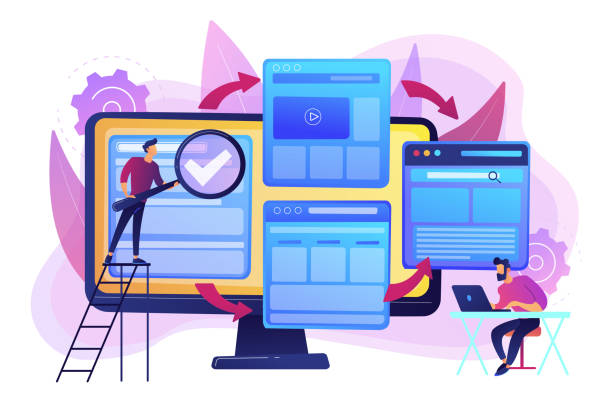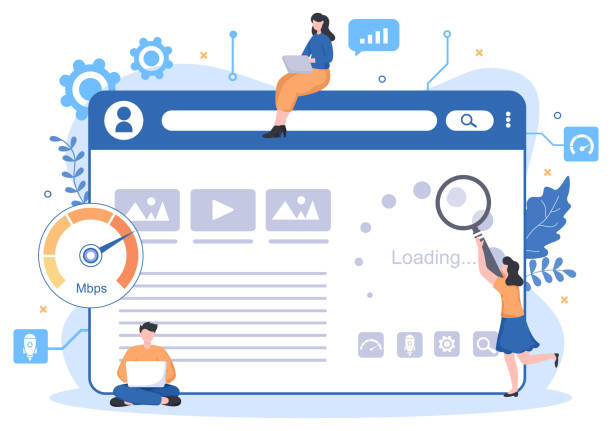Introduction to Fast Website Design and Its Importance

In today’s digital world where speed is paramount, fast website design is more than a benefit, it’s a vital necessity.
Internet users have little patience and expect websites to load in a fraction of a second.
If your website is slow, you not only provide a poor user experience (#UX), but your ranking in search engines (#SEO) will also significantly drop.
This directly affects your traffic, conversion rate, and ultimately the success of your online business.
Studies show that even a one-second delay in page loading can lead to a significant decrease in customer satisfaction and conversion rates.
This section provides a comprehensive explanation of why website speed is important and serves as a basic tutorial.
The main goal is to understand why we should consider fast and optimized website design.
The importance of website speed is not limited to users.
Search engines like Google also consider page load speed as an important factor in website ranking.
Slower websites appear less in search results, which means losing countless opportunities to attract organic traffic.
Search Engine Optimization (SEO) would be incomplete without considering website load speed.
Therefore, investing in high-speed website design is an investment in the future of your business.
This not only improves user experience, but also indirectly affects your sales growth and brand credibility.
In future chapters, we will delve into more details on how to achieve fast website design.
Are you dissatisfied with the low conversion rate of visitors to customers on your e-commerce site?
Solve this problem forever with professional e-commerce website design by Rasaweb!
✅ Increase visitor-to-customer conversion rate
✅ Create an excellent user experience and gain customer trust
⚡ Get free consultation
Key Factors Affecting Website Speed

To achieve fast website design, we must first identify the main factors affecting website load speed.
These factors can vary in many aspects, from server infrastructure to website coding details.
One of the most important of these factors is hosting server quality.
Low-quality servers or overcrowded shared hosting can significantly slow down your website.
Choosing a reputable hosting provider suitable for your website’s traffic needs is the first step towards fast website design.
Another factor is file size and optimization.
Large and unoptimized images, videos, CSS, and JavaScript files can significantly increase load times.
Optimizing these files through compression, minification, and using modern formats is essential for fast website design.
Excess and unnecessary plugins and scripts can also put a heavy load on the server and reduce site speed.
A detailed analytical review of the codes and plugins used, to identify and remove unnecessary items, is highly specialized and vital.
The database also plays an important role; cluttered and unoptimized databases can severely affect website responsiveness.
Finally, website coding and its architecture are also important factors.
Complex, non-standard, or error-prone codes can make browser processing difficult and reduce load speed.
Using lightweight frameworks, optimizing DOM structure, and lazy loading resources are all solutions that contribute to developing a high-speed website.
Optimizing Images and Media for Speed Increase

Images and media often constitute the largest portion of a web page’s size, and thus, their optimization plays a pivotal role in fast website design.
If your images are not properly optimized, even the best server and coding cannot make your site fast.
The first step in this regard is image compression.
Many online and offline tools exist that can reduce image file size without a noticeable loss in quality.
Using modern image formats like WebP, which offers better compression than JPEG and PNG, is a very effective guideline for fast website design.
In addition to compression, choosing appropriate image dimensions is also important.
There’s no need to load a 4000-pixel image to display it in a 200-pixel space.
Images should be optimized and delivered in the dimensions they are intended to be displayed on the website.
The Lazy Loading feature is also a specialized technique that allows the site to load images only when the user needs them and has scrolled to that section of the page.
This significantly increases initial load speed, especially for long pages with many images.
Using Alt Text for images is not only important for SEO but also helps improve accessibility and, consequently, user experience.
Proper video management is as important as image management.
Using video hosting services like YouTube or Vimeo, instead of directly uploading videos to your own server, can significantly reduce the load on your server.
These comprehensive approaches are the cornerstone of fast and high-performing website design.
| Method | Description | Benefit for Site Speed |
|---|---|---|
| Image Compression | Reduces image file size without significant quality loss by using compression tools and algorithms. | Reduces image load time, saves bandwidth. |
| Using WebP Format | Converting images to WebP format, which offers higher compression than JPG and PNG. | Smaller file sizes, faster loading. |
| Lazy Loading | Loading images and videos only when the user scrolls to them. | Increases initial page load speed, improves user experience. |
| Choosing Appropriate Dimensions | Using images with dimensions appropriate for their display area on the website. | Prevents loading images larger than necessary and reduces unnecessary loading. |
| External Video Hosting | Using services like YouTube or Vimeo to host videos. | Reduces load on the main server, improves overall site performance. |
The Role of Hosting and CDN in Site Performance

One of the main pillars of fast website design is choosing the right hosting service and using a CDN (Content Delivery Network).
Even if your website is in the best condition in terms of coding and content optimization, a weak or inaccessible server can nullify all your efforts.
Your hosting service is essentially your website’s home on the internet, and the quality of this home directly affects the access speed for visitors.
Cheap shared hosting might be suitable for starters, but for websites with moderate to high traffic, they are often insufficient and lead to slower speeds.
Choosing a specialized and reliable hosting, including VPS, dedicated, or cloud hosting, is an essential step for fast and stable website design.
Alongside hosting, CDN is an excellent tool for increasing website load speed, especially for users from different geographical regions.
CDN copies and stores your website’s static content (such as images, CSS, and JavaScript) on multiple servers worldwide.
When a user requests to view your website, the content is delivered to them from the closest CDN server, which significantly reduces latency and increases load speed.
This is an explanatory and very efficient solution for improving website accessibility and speed globally.
CDN can also protect against DDoS attacks and reduce the load on your main server.
By distributing traffic load across various servers, CDN helps ensure your website’s stability and availability, even during peak traffic.
This combination of strong hosting and an efficient CDN will guarantee fast and high-performance website design.
Many CDN providers also offer other features such as compression, caching, and image optimization, which generally help improve speed.
Do you have an e-commerce site, but your sales are not as expected? Rasaweb solves your problem forever with professional e-commerce website design!
✅ Significant increase in conversion rates and sales
✅ Unparalleled user experience for your customers
⚡ Click to get free consultation with Rasaweb!
Clean Coding and Front-End Code Optimization

Website coding, especially front-end codes (HTML, CSS, JavaScript), directly affects page load and rendering speed.
To achieve fast website design, adhering to clean coding principles and optimizing them is crucial.
One of the most important actions is Minification of CSS and JavaScript codes.
This process involves removing extra characters such as spaces, tabs, comments, and newlines, which reduces file size and speeds up load time.
The next step is Concatenation of files.
Instead of loading multiple separate CSS or JavaScript files, it’s better to combine them into one or a few larger files.
This reduces the number of HTTP requests to the server, which in turn means faster website loading.
Also, Asynchronous Loading for scripts, especially JavaScript, is highly recommended.
By using `async` or `defer` attributes in script tags, the browser can continue loading other page components simultaneously with script loading, which significantly contributes to fast website design.
Using Inline CSS and JavaScript in HTML is only recommended for very small codes; otherwise, it leads to an increase in HTML file size and slower rendering.
The best guidance is to keep CSS codes in separate files within the `
Furthermore, reducing DOM complexity (Document Object Model) by removing unnecessary and nested HTML tags can also help improve performance.
These specialized approaches in coding are the cornerstone of developing a high-speed website.
Using Caching and Compression for Faster Loading

Caching and Compression are two powerful tools in website speed optimization that every developer should be expertly familiar with.
Caching allows browsers, servers, or CDNs to temporarily store copies of your website content so that they load faster on subsequent visits or for other users.
This significantly reduces the number of requests to the main server and contributes to the speed of fast website design.
There are various types of caching, including Browser Caching which stores static files like CSS, JavaScript, and images on the user’s computer, and Server-side Caching which can include database cache, object cache (like Redis or Memcached), and page cache.
Activating browser caching via the .htaccess file or server settings tells browsers how long they can store copies of your content.
This is a fundamental tutorial for increasing speed for repeat visitors.
On the other hand, Gzip compression is one of the most effective methods to reduce the volume of data sent from the server to the browser.
Gzip can reduce the size of HTML, CSS, and JavaScript files by up to 70 percent.
Activating Gzip on the web server automatically compresses content before sending it to the browser, and the browser uncompresses it.
This process is completely transparent to the user and significantly increases data transfer speed.
The correct combination of caching and compression strategies has a significant impact on fast and efficient website design.
Caching can significantly improve performance, especially on dynamic sites like online stores or blogs where content does not constantly change.
By implementing these guided techniques, you can provide a high-speed and optimized experience for your users.
Website Speed Tools and Tests

To ensure that your efforts for fast website design have paid off, you need to use analytical and speed testing tools.
These tools help you identify your website’s weaknesses and measure the improvements achieved after making changes.
One of the most well-known and reputable tools is Google PageSpeed Insights.
This tool gives you a score out of 100 and provides suggestions for improving speed on both desktop and mobile.
PageSpeed Insights focuses on Google’s Core Web Vitals metrics (Largest Contentful Paint, First Input Delay, Cumulative Layout Shift) which directly impact user experience and SEO.
Other tools such as GTmetrix and Pingdom Tools are also very popular and useful.
GTmetrix provides very detailed and specialized information about website performance, including a Waterfall Chart that shows how long each file takes to load.
Pingdom Tools also provides detailed reports on load time, page size, and the number of requests.
These tools give you a comprehensive overview of your site’s performance by simulating website loading from different parts of the world.
It is important to correctly interpret the results of these tests.
Each tool may have different metrics and suggestions.
The ultimate goal should not just be to achieve a score of 100 in one tool, but to truly improve user experience.
A key guideline is to regularly test your website with these tools, especially after any major changes to the site’s content or structure, to ensure that your fast website design is maintained.
| Tool | Main Focus | Advantage | Key Metrics |
|---|---|---|---|
| Google PageSpeed Insights | User Experience and SEO (Core Web Vitals) | Google scores and suggestions, mobile and desktop testing. | LCP, FID, CLS |
| GTmetrix | Technical Website Performance Details | Waterfall chart, precise suggestions for improvement, performance history. | Page Speed Score, YSlow Score |
| Pingdom Tools | Load Time and Resource Analysis | Testing from various locations, simple and practical reports. | Load Time, Page Size, Requests |
| WebPageTest | Advanced Testing and Complex Scenarios | Ability to configure multiple tests (e.g., resource prioritization), screen recording of page loading. | First Byte Time, Start Render, Speed Index |
Security and Fast Website Design: An Inseparable Connection

At first glance, the direct connection between website security and fast website design might seem unclear, but in reality, these two aspects are highly interconnected.
An insecure website can quickly turn into a slow one.
Malicious attacks, malware infections, or even the presence of security vulnerabilities that lead to exploitation can consume your server resources and significantly reduce page load speeds.
This is an important news for any website administrator seeking optimal performance.
Using the HTTPS protocol instead of HTTP is not only vital for user data security but can also help improve load speed.
HTTP/2, which is the underlying protocol for HTTPS, allows for concurrent loading of multiple files, which in itself contributes to developing a high-speed website.
Furthermore, using a Web Application Firewall (WAF) can protect your website against common attacks and prevent excessive server resource consumption.
These specialized tools not only enhance security but also contribute to the stability of website performance.
Regular updates of website software (CMS, themes, plugins) are also a critical factor in maintaining security and speed.
Older versions may have known vulnerabilities that hackers can exploit.
Moreover, newer versions often come with performance and security enhancements that contribute to fast and stable website design.
Ignoring security can lead to heavy costs (such as malware removal or data recovery) and loss of credibility, all of which indirectly affect your website’s speed and availability.
This is a complete explanation of the vital connection between these two topics.
Are you losing business opportunities due to an outdated website? With Rasaweb, permanently solve the problem of not attracting potential customers through your website!
✅ Attract more high-quality leads
✅ Increase brand credibility in the eyes of customers
⚡ Get free corporate website design consultation
Engaging Content and Its Role in Fast User Experience

Although fast website design largely pertains to technical aspects, the role of content in the user’s perception of website speed is crucial.
Engaging, attractive, and high-quality content can keep users on your website longer and reduce the Bounce Rate.
This means that even if the initial load takes a little longer, the quality of the content can improve the overall user experience and make the user feel that their time has been effectively spent.
In fact, a website with moderate speed but incredibly entertaining and useful content might seem faster to the user than a super-fast website with worthless content.
For example, using engaging and relevant images and videos, a well-organized and readable layout, and interactive elements like surveys or quizzes can further engage users.
If properly optimized, these elements not only don’t reduce speed but also contribute to fast and attractive website design.
Storytelling and narrative content can also enrich the user experience.
These approaches make users feel their time on the website has been well spent, even if it took a few more seconds to load.
Clear and logical Call-to-Action is also part of optimized content.
When users quickly find what they are looking for and have a clear path for the next action, they will feel more efficient and perceive greater speed.
This is a non-technical but very effective guideline for improving the sense of speed and efficiency of a website.
In summary, fast website design is not limited to optimized codes and a powerful server, but also depends on the quality and type of content you provide, and this is a matter that should be considered.
The Future of Fast Website Design and New Trends

The web industry is evolving rapidly, and with it, the standards for fast website design are also changing.
Understanding new trends and emerging technologies is essential for anyone looking to maintain a high-speed and competitive website.
One of the most important recent trends is Google’s focus on Core Web Vitals.
These critical performance metrics not only affect SEO but are also considered key indicators of a fast user experience.
Websites must continuously analyze and improve their performance based on these metrics.
HTTP/3, the next generation of the HTTP protocol, has been developed with the aim of further improving web communication speed and security.
Based on QUIC, this protocol promises to make website loading even faster than HTTP/2 by reducing latency and improving data stream management.
Widespread adoption of HTTP/3 in the near future can significantly contribute to faster website design globally.
Furthermore, technologies like WebAssembly are emerging, enabling high-performance code execution directly in the browser and potentially leading to the development of more complex web applications with near-native speeds.
This is exciting news for developers.
Artificial Intelligence (AI) and Machine Learning (ML) are also gradually entering the field of website optimization.
Tools are being developed that can automatically apply performance optimizations based on user behavior and traffic patterns.
This specialized and automated approach will revolutionize the future of fast website design.
By being aware of these trends and investing in new technologies, you can ensure that your website is not only fast today but also ready for future challenges.
This is continuous learning in the fast-paced world of the web.
Frequently Asked Questions
| Row | Question | Answer |
|---|---|---|
| 1 | What is meant by fast website design? | Fast website design refers to the process of launching a functional and optimized website in the shortest possible time, without sacrificing its quality or efficiency. |
| 2 | What factors are effective in website design speed? | Using ready-made Content Management Systems (CMS) like WordPress, optimized ready-made templates, visual design tools, designer’s experience, and effective communication with the client. |
| 3 | Does fast website design always mean reduced quality? | No, with proper planning, using optimized tools, and standard techniques, a high-quality website can be designed in a short time. |
| 4 | What types of websites are most suitable for fast design? | Small corporate websites, blogs, online resumes, landing pages, and e-commerce stores with limited products. |
| 5 | What is the role of CMSs (like WordPress) in fast design? | CMSs significantly accelerate the design and development process by providing themes, plugins, and an easy-to-use administration panel. |
| 6 | Does fast website design cost less? | Usually, yes. Due to reduced designer work time and the use of ready-made resources, costs can be significantly lowered. |
| 7 | What client information is needed for fast design? | Contact information, logo, text content, images, website goals, and any specific customization needs. |
| 8 | Can fast-designed websites be developed further in the future? | Yes, especially if built with popular CMSs like WordPress, new features can easily be added to them in the future. |
| 9 | What are the benefits of fast website design for businesses? | Faster market entry, testing new ideas with minimal risk, cost reduction, and the possibility of launching immediate marketing campaigns. |
| 10 | What is the difference between fast website design and a “ready-made site”? | Fast design involves the process of designing and implementing based on client needs, although it uses ready-made tools. However, a “ready-made site” usually refers to platforms where you simply input your information and receive a predefined website. |
And other services of Rasaweb Advertising Agency in the field of advertising
Smart Marketing Automation: A fast and efficient solution for user engagement, focusing on SEO-driven content strategy.
Smart Data Analysis: A blend of creativity and technology for digital branding through custom programming.
Smart Direct Marketing: A combination of creativity and technology for online growth through attractive UI design.
Smart Customer Journey Mapping: An effective tool to increase website traffic by utilizing real data.
Smart Marketing Automation: An effective tool for digital branding by utilizing real data.
And over hundreds of other services in the field of internet advertising, advertising consultation, and organizational solutions
Internet Advertising | Advertising Strategy | Advertorial
Resources
- Improve Website Speed with W3Schools
- Website Speed Optimization by Kinsta
- About Google PageSpeed Insights
- Fast Websites on web.dev
✅? At Rasaweb Afarin Digital Marketing Agency, your digital dreams come true with our expertise. From professional SEO optimization to secure website design and creative advertising campaigns, we are your partner in the digital world.
📍 Tehran, Mirdamad Street, next to Bank Markazi, Southern Kazeroon Alley, Ramin Alley No. 6


